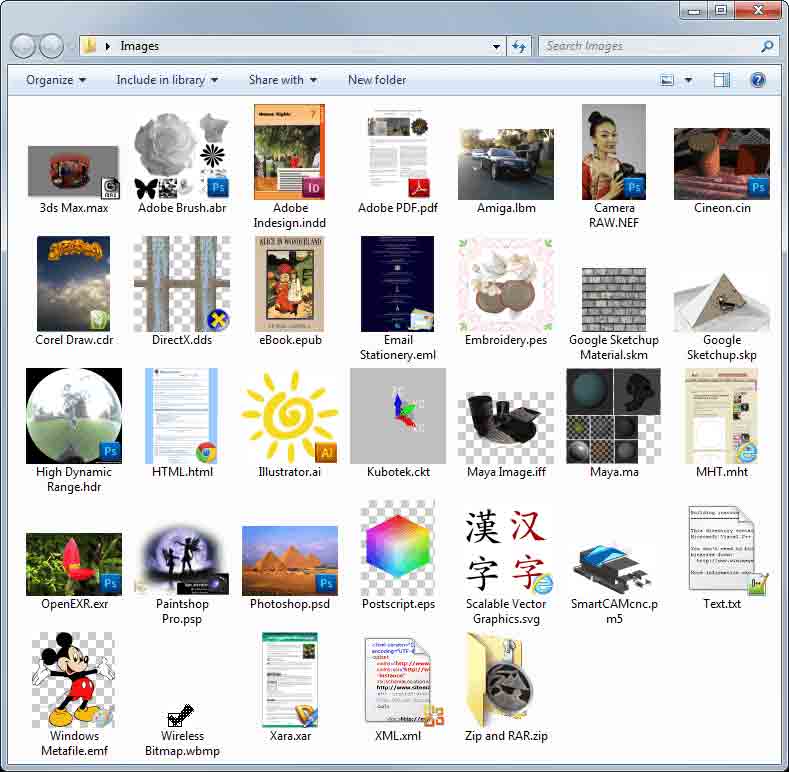Thumbnails of 32-bit resolution and as large as 256x256 pixels are often used in Windows Vista UI. File format owners should be prepared to display their thumbnails at that size. They should also provide non-static images for their thumbnails that reflect the particular file's contents. For example, a text file's thumbnail should show a miniature version of the document, including its text. The interface has been introduced to make providing a thumbnail easier and more straightforward than in the past, when would have been used instead. Note, that existing code that uses IExtractImage is still valid under Windows Vista.
However, IExtractImage is not supported in the Details pane. This topic discusses the following: • • • • • • Thumbnail Processes Handlers, including thumbnail handlers, run by default in a separate process. You can force the handler to run in-process by passing a NULL value as the bind context in a call to as shown here.
I found this old forum thread where someone had made a program so that windows works better with mobi files. Instead of just displaying a blank card or one with word 'mobi' on it, in thumbnails you'd see the cover for the book. It does not though work with epub or pdf, or any other sort of ebook file. As some of you likely know, Windows Explorer or File Explorer doesn’t support thumbnail view feature for all file types. While most of the popular video and image file types are supported, icons are displayed instead of thumbnails for many file types.
If an image is not square, you should not pad it yourself. Windows is responsible for respecting the original aspect ratio and padding the image to a square size.
As the name implies, Yodot RAR Repair is a tool designed to restore RAR archives that are corrupted or damaged to various errors, such as the one due to the file extension, for instance. After a swift and uneventful setup, you are welcomed by a small window that prompts you to specify the path to the file that needs to be repaired. Free yodot activation key.
When an image of a particular size is asked for, unless an exact match is found, Windows Vista always retrieves the next largest image and scales it down to the requested size. An image is never scaled up in size as was the case in previous versions of Windows.

The following table gives some examples of the relationship between requested size and available size. Corel brushes free. Maximum Image Size You Provide Size Requested by the Extractor You Provide 156x120 256x256 156x120 (Do not pad, maintain aspect ratio) 2048x1024 256x256 256x128 (Do not pad, maintain aspect ratio) You can declare a cutoff point as part of the file association entry in the registry. Below this size, thumbnails are not used. HKEY_CLASSES_ROOT.fileextension ThumbnailCutoff The ThumbnailCutoff entry is one of these REG_DWORD values.
Value Cutoff HighDPI Sensitive 0 32x32 Yes 1 16x16 Yes 2 48x48 Yes 3 16x16 Yes High dots per inch (dpi) sensitivity means that the pixel dimensions of the thumbnail automatically adjust for the greater dpi. For instance, a 32x32 image at 96 dpi would be a 40x40 image at 120 dpi. If the ThumbnailCutoff entry is not specified, the default cutoff is 20x20 (not dpi-sensitive).
Thumbnail Overlays Thumbnail overlays, a small image displayed over the lower right corner of the thumbnail, provide an opportunity for developers to apply brand identification to their thumbnails. Overlays are declared in the registry as part of the file association entry as shown here: HKEY_CLASSES_ROOT.fileextension TypeOverlay The TypeOverlay entry contains a REG_SZ value interpreted as follows: • If the value is a resource reference, such as ISVComponent.dll@,-155, that image is used as the overlay for files with that file name extension. • If the value is an empty string, no overlay is applied to the image.
• If the value is not present, the default icon of the associated application is used. Overlays for your thumbnails should only be provided through this mechanism and applied by Windows. Do not apply overlays yourself. Thumbnail Adornments Adornments such as drop shadows are applied to thumbnails based on the user's currently selected theme. Adornments are provided by Windows; do not create them yourself. Windows could change the look of particular adornments at any time, so if you provided you own you would risk falling out of synch with the system.
Your thumbnails could wind up looking dated or out of place. Potential adornments are declared in the registry as part of the file association entry as shown here: HKEY_CLASSES_ROOT.fileextension Treatment The Treatment entry contains one of these REG_DWORD values: Value Meaning 0 No Adornment 1 Drop Shadow 2 Photo Border 3 Video Sprockets A drop shadow is applied to images by default.